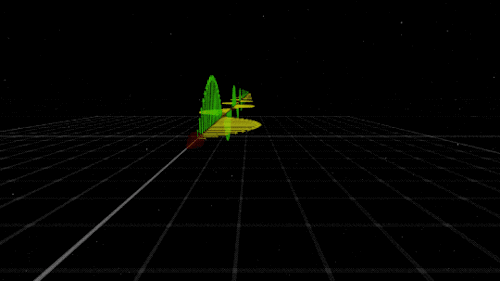May The Four Forces Be With You!
May the Four Forces Be With You!
May the force be with you? Much to learn you still have, padawan. In our universe it would be more appropriate to say, “May the four forces be with you.”

There are four fundamental forces that bind our universe and its building blocks together. Two of them are easy to spot — gravity keeps your feet on the ground while electromagnetism keeps your devices running. The other two are a little harder to see directly in everyday life, but without them, our universe would look a lot different!
Let’s explore these forces in a little more detail.
Gravity: Bringing the universe together

If you jump up, gravity brings you back down to Earth. It also keeps the solar system together … and our galaxy, and our local group of galaxies and our supercluster of galaxies.
Gravity pulls everything together. Everything, from the bright centers of the universe to the planets farthest from them. In fact, you (yes, you!) even exert a gravitational force on a galaxy far, far away. A tiny gravitational force, but a force nonetheless.

Credit: NASA and the Advanced Visualization Laboratory at the National Center for Supercomputing and B. O'Shea, M. Norman
Despite its well-known reputation, gravity is actually the weakest of the four forces. Its strength increases with the mass of the two objects involved. And its range is infinite, but the strength drops off as the square of the distance. If you and a friend measured your gravitational tug on each other and then doubled the distance between you, your new gravitational attraction would just be a quarter of what it was. So, you have to be really close together, or really big, or both, to exert a lot of gravity.
Even so, because its range is infinite, gravity is responsible for the formation of the largest structures in our universe! Planetary systems, galaxies and clusters of galaxies all formed because gravity brought them together.
Gravity truly surrounds us and binds us together.
Electromagnetism: Lighting the way

You know that shock you get on a dry day after shuffling across the carpet? The electricity that powers your television? The light that illuminates your room on a dark night? Those are all the work of electromagnetism. As the name implies, electromagnetism is the force that includes both electricity and magnetism.
Electromagnetism keeps electrons orbiting the nucleus at the center of atoms and allows chemical compounds to form (you know, the stuff that makes up us and everything around us). Electromagnetic waves are also known as light. Once started, an electromagnetic wave will travel at the speed of light until it interacts with something (like your eye) — so it will be there to light up the dark places.

Like gravity, electromagnetism works at infinite distances. And, also like gravity, the electromagnetic force between two objects falls as the square of their distance. However, unlike gravity, electromagnetism doesn’t just attract. Whether it attracts or repels depends on the electric charge of the objects involved. Two negative charges or two positive charges repel each other; one of each, and they attract each other. Plus. Minus. A balance.
This is what happens with common household magnets. If you hold them with the same “poles” together, they resist each other. On the other hand, if you hold a magnet with opposite poles together — snap! — they’ll attract each other.
Electromagnetism might just explain the relationship between a certain scruffy-looking nerf-herder and a princess.
Strong Force: Building the building blocks

Credit: Lawrence Livermore National Laboratory
The strong force is where things get really small. So small, that you can’t see it at work directly. But don’t let your eyes deceive you. Despite acting only on short distances, the strong force holds together the building blocks of the atoms, which are, in turn, the building blocks of everything we see around us.
Like gravity, the strong force always attracts, but that’s really where their similarities end. As the name implies, the force is strong with the strong force. It is the strongest of the four forces. It brings together protons and neutrons to form the nucleus of atoms — it has to be stronger than electromagnetism to do it, since all those protons are positively charged. But not only that, the strong force holds together the quarks — even tinier particles — to form those very protons and neutrons.
However, the strong force only works on very, very, very small distances. How small? About the scale of a medium-sized atom’s nucleus. For those of you who like the numbers, that’s about 10-15 meters, or 0.000000000000001 meters. That’s about a hundred billion times smaller than the width of a human hair! Whew.
Its tiny scale is why you don’t directly see the strong force in your day-to-day life. Judge a force by its physical size, do you?
Weak Force: Keeping us in sunshine

If you thought it was hard to see the strong force, the weak force works on even smaller scales — 1,000 times smaller. But it, too, is extremely important for life as we know it. In fact, the weak force plays a key role in keeping our Sun shining.
But what does the weak force do? Well … that requires getting a little into the weeds of particle physics. Here goes nothing! We mentioned quarks earlier — these are tiny particles that, among other things, make up protons and neutrons. There are six types of quarks, but the two that make up protons and neutrons are called up and down quarks. The weak force changes one quark type into another. This causes neutrons to decay into protons (or the other way around) while releasing electrons and ghostly particles called neutrinos.
So for example, the weak force can turn a down quark in a neutron into an up quark, which will turn that neutron into a proton. If that neutron is in an atom’s nucleus, the electric charge of the nucleus changes. That tiny change turns the atom into a different element! Such reactions are happening all the time in our Sun, giving it the energy to shine.
The weak force might just help to keep you in the (sun)light.

All four of these forces run strong in the universe. They flow between all things and keep our universe in balance. Without them, we’d be doomed. But these forces will be with you. Always.
You can learn more about gravity from NASA’s Space Place and follow NASAUniverse on Twitter or Facebook to learn about some of the cool cosmic objects we study with light.
Make sure to follow us on Tumblr for your regular dose of space: http://nasa.tumblr.com
More Posts from Thehkr and Others
Throwback Thursday: Apollo 11 FAQ Edition

With the help of the NASA History Office, we’ve identified some of the most frequently asked questions surrounding the first time humans walked on the surface of another world. Read on and click here to check out our previous Apollo FAQs.
How many moon rocks did the Apollo crews bring back? What did we learn?

The six crews that landed on the Moon brought back 842 pounds (382 kilograms) of rocks, sand and dust from the lunar surface. Each time, they were transferred to Johnson Space Center’s Lunar Receiving Laboratory, a building that also housed the astronauts during their three weeks of quarantine. Today the building now houses other science divisions, but the lunar samples are preserved in the Lunar Sample Receiving Laboratory.
Built in 1979, the laboratory is the chief repository of the Apollo samples.

From these pieces of the Moon we learned that its chemical makeup is similar to that of Earth’s, with some differences. Studying the samples has yielded clues to the origins of the solar system. In March of 2019, we announced that three cases of pristine Moon samples will be unsealed for the first time in 50 years so that we can take advantage of the improved technology that exists today!
Did you know you might not have to travel far to see a piece of the Moon up close? Visit our Find a Moon Rock page to find out where you can visit a piece of the Moon.
What did Apollo astronauts eat on their way to the Moon?

Astronaut food has come a long way since the days of Project Mercury, our first human spaceflight program that ran from 1958-1963. Back then, astronauts “enjoyed” food in cube form or squeezed out of tubes. Early astronaut food menus were designed less for flavor and more for nutritional value, but that eventually shifted as technology evolved. Astronauts today can enjoy whole foods like apples, pizza and even tacos.
Apollo crews were the first to have hot water, making it easier to rehydrate their foods and improve its taste. They were also the first to use a “spoon bowl,” a plastic container that was somewhat like eating out of a Ziploc bag with a spoon. Here’s an example of a day’s menu for a voyage to the Moon:
Breakfast: bacon squares, strawberry cubes and an orange drink.
Lunch: beef and potatoes, applesauce and a brownie.
Dinner: salmon salad, chicken and rice, sugar cookie cubes and a pineapple grapefruit drink.
What did Michael Collins do while he orbited the Moon, alone in the Command Module?

As Neil Armstrong and Buzz Aldrin worked on the lunar surface, Command Module pilot Michael Collins orbited the Moon, alone, for the next 21.5 hours. On board he ran systems checks, made surface observations and communicated with Mission Control when there wasn’t a communications blackout. Blackouts happened every time Collins went behind the Moon. In 2009, Collins wrote this in response to a flurry of media questions about the 40th anniversary of the mission:
Q. Circling the lonely Moon by yourself, the loneliest person in the universe, weren’t you lonely? A. No. Far from feeling lonely or abandoned, I feel very much a part of what is taking place on the lunar surface. I know that I would be a liar or a fool if I said that I have the best of the three Apollo 11 seats, but I can say with truth and equanimity that I am perfectly satisfied with the one I have. This venture has been structured for three men, and I consider my third to be as necessary as either of the other two.”
What will Artemis astronauts bring back when they land on the Moon?

Artemis missions to the Moon will mark humanity’s first permanent presence on another world. The first woman and the next man to explore the lunar surface will land where nobody has ever attempted to land before – on the Moon’s south pole where there are billions of tons of water ice that can be used for oxygen and fuel. We don’t know yet what astronauts will bring back from this unexplored territory, but we do know that they will return with hope and inspiration for the next generation of explorers: the Artemis generation. Make sure to follow us on Tumblr for your regular dose of space: http://nasa.tumblr.com.
The Artemis Story: Where We Are Now and Where We’re Going

Using a sustainable architecture and sophisticated hardware unlike any other, the first woman and the next man will set foot on the surface of the Moon by 2024. Artemis I, the first mission of our powerful Space Launch System (SLS) rocket and Orion spacecraft, is an important step in reaching that goal.
As we close out 2019 and look forward to 2020, here’s where we stand in the Artemis story — and what to expect in 2020.
Cranking Up The Heat on Orion
The Artemis I Orion spacecraft arrived at our Plum Brook Station in Sandusky, Ohio, on Tuesday, Nov. 26 for in-space environmental testing in preparation for Artemis I.
This four-month test campaign will subject the spacecraft, consisting of its crew module and European-built service module, to the vacuum, extreme temperatures (ranging from -250° to 300° F) and electromagnetic environment it will experience during the three-week journey around the Moon and back. The goal of testing is to confirm the spacecraft’s components and systems work properly under in-space conditions, while gathering data to ensure the spacecraft is fit for all subsequent Artemis missions to the Moon and beyond. This is the final critical step before the spacecraft is ready to be joined with the Space Launch System rocket for this first test flight in 2020!
Bringing Everyone Together

On Dec. 9, we welcomed members of the public to our Michoud Assembly Facility in New Orleans for #Artemis Day and to get an up-close look at the hardware that will help power our Artemis missions. The 43-acre facility has more than enough room for guests and the Artemis I, II, and III rocket hardware! NASA Administrator Jim Bridenstine formally unveiled the fully assembled core stage of our SLS rocket for the first Artemis mission to the Moon, then guests toured of the facility to see flight hardware for Artemis II and III. The full-day event — complete with two panel discussions and an exhibit hall — marked a milestone moment as we prepare for an exciting next phase in 2020.
Rolling On and Moving Out

Once engineers and technicians at Michoud complete functional testing on the Artemis I core stage, it will be rolled out of the Michoud factory and loaded onto our Pegasus barge for a very special delivery indeed. About this time last year, our Pegasus barge crew was delivering a test version of the liquid hydrogen tank from Michoud to NASA’s Marshall Space Flight Center in Huntsville for structural testing. This season, the Pegasus team will be transporting a much larger piece of hardware — the entire core stage — on a slightly shorter journey to the agency’s nearby Stennis Space Center near Bay St. Louis, Mississippi.
Special Delivery

Why Stennis, you ask? The giant core stage will be locked and loaded into the B2 Test Stand there for the landmark Green Run test series. During the test series, the entire stage, including its extensive avionics and flight software systems, will be tested in full. The series will culminate with a hot fire of all four RS-25 engines and will certify the complex stage “go for launch.” The next time the core stage and its four engines fire as one will be on the launchpad at NASA’s Kennedy Space Center in Florida.
Already Working on Artemis II

As Orion and SLS make progress toward the pad for Artemis I, employees at NASA centers and large and small companies across America are hard at work assembling and manufacturing flight hardware for Artemis II and beyond. The second mission of SLS and Orion will be a test flight with astronauts aboard that will go around the Moon before returning home. Our work today will pave the way for a new generation of moonwalkers and Artemis explorers.
Make sure to follow us on Tumblr for your regular dose of space: http://nasa.tumblr.com.


Guy Bluford Changed the Course of Space History
On Aug. 30, 1983, Guion Bluford, better known as Guy, became the first African American to fly to space. An accomplished jet pilot and aerospace engineer, Bluford became part of NASA’s 1978 astronaut class that included the first African American, the first Asian American, and the first women astronauts.
He and the other crew members of mission STS-8 were aboard the orbiter Challenger as it lifted off from Kennedy Space Center in Florida; it was the first nighttime launch and landing of the Space Shuttle program. While aboard, he and the other crew members deployed the Indian National Satellite (INSAT-1B), operated a Canadian-built robot arm, conducted experiments with live cell samples, and participated in studies measuring the effects of spaceflight on humans.
Guy Bluford chased his childhood dream of becoming an aerospace engineer, and in doing so, changed history and encouraged other Black astronauts to follow in his footsteps.
Make sure to follow us on Tumblr for your regular dose of space—and for milestones like this!

“Sometimes people with the worst past end up creating the best future.”
— Unknown


Cosmic Alphabet Soup: Classifying Stars

If you’ve spent much time stargazing, you may have noticed that while most stars look white, some are reddish or bluish. Their colors are more than just pretty – they tell us how hot the stars are. Studying their light in greater detail can tell us even more about what they’re like, including whether they have planets. Two women, Williamina Fleming and Annie Jump Cannon, created the system for classifying stars that we use today, and we’re building on their work to map out the universe.

By splitting starlight into spectra – detailed color patterns that often feature lots of dark lines – using a prism, astronomers can figure out a star’s temperature, how long it will burn, how massive it is, and even how big its habitable zone is. Our Sun’s spectrum looks like this:

Astronomers use spectra to categorize stars. Starting at the hottest and most massive, the star classes are O, B, A, F, G (like our Sun), K, M. Sounds like cosmic alphabet soup! But the letters aren’t just random – they largely stem from the work of two famous female astronomers.

Williamina Fleming, who worked as one of the famous “human computers” at the Harvard College Observatory starting in 1879, came up with a way to classify stars into 17 different types (categorized alphabetically A-Q) based on how strong the dark lines in their spectra were. She eventually classified more than 10,000 stars and discovered hundreds of cosmic objects!

That was back before they knew what caused the dark lines in spectra. Soon astronomers discovered that they’re linked to a star’s temperature. Using this newfound knowledge, Annie Jump Cannon – one of Fleming’s protégés – rearranged and simplified stellar classification to include just seven categories (O, B, A, F, G, K, M), ordered from highest to lowest temperature. She also classified more than 350,000 stars!

Type O stars are both the hottest and most massive in the new classification system. These giants can be a thousand times bigger than the Sun! Their lifespans are also around 1,000 times shorter than our Sun’s. They burn through their fuel so fast that they only live for around 10 million years. That’s part of the reason they only make up a tiny fraction of all the stars in the galaxy – they don’t stick around for very long.

As we move down the list from O to M, stars become progressively smaller, cooler, redder, and more common. Their habitable zones also shrink because the stars aren’t putting out as much energy. The plus side is that the tiniest stars can live for a really long time – around 100 billion years – because they burn through their fuel so slowly.

Astronomers can also learn about exoplanets – worlds that orbit other stars – by studying starlight. When a planet crosses in front of its host star, different kinds of molecules in the planet’s atmosphere absorb certain wavelengths of light.
By spreading the star’s light into a spectrum, astronomers can see which wavelengths have been absorbed to determine the exoplanet atmosphere’s chemical makeup. Our James Webb Space Telescope will use this method to try to find and study atmospheres around Earth-sized exoplanets – something that has never been done before.

Our upcoming Nancy Grace Roman Space Telescope will study the spectra from entire galaxies to build a 3D map of the cosmos. As light travels through our expanding universe, it stretches and its spectral lines shift toward longer, redder wavelengths. The longer light travels before reaching us, the redder it becomes. Roman will be able to see so far back that we could glimpse some of the first stars and galaxies that ever formed.
Learn more about how Roman will study the cosmos in our other posts:
Roman’s Family Portrait of Millions of Galaxies
New Rose-Colored Glasses for Roman
How Gravity Warps Light
Make sure to follow us on Tumblr for your regular dose of space!

It should be emphasized that the safety of police officers is recognized as a fundamental concern. No responsible citizen expects a police officer to risk his or her life unnecessarily or foolishly.
-
 glaciesdeam liked this · 2 months ago
glaciesdeam liked this · 2 months ago -
 wolfsrahne28 liked this · 1 year ago
wolfsrahne28 liked this · 1 year ago -
 brandon1997 liked this · 1 year ago
brandon1997 liked this · 1 year ago -
 demichrising liked this · 1 year ago
demichrising liked this · 1 year ago -
 novelteastuff liked this · 1 year ago
novelteastuff liked this · 1 year ago -
 vermilionvexation liked this · 1 year ago
vermilionvexation liked this · 1 year ago -
 uriigamii liked this · 1 year ago
uriigamii liked this · 1 year ago -
 uhleesuhsimports reblogged this · 1 year ago
uhleesuhsimports reblogged this · 1 year ago -
 ivansirko liked this · 2 years ago
ivansirko liked this · 2 years ago -
 fabcity liked this · 2 years ago
fabcity liked this · 2 years ago -
 raf-science reblogged this · 2 years ago
raf-science reblogged this · 2 years ago -
 abelhaplanta reblogged this · 2 years ago
abelhaplanta reblogged this · 2 years ago -
 wherethestoriesare reblogged this · 2 years ago
wherethestoriesare reblogged this · 2 years ago -
 wherethestoriesare liked this · 2 years ago
wherethestoriesare liked this · 2 years ago -
 doa333 reblogged this · 2 years ago
doa333 reblogged this · 2 years ago -
 doa333 liked this · 2 years ago
doa333 liked this · 2 years ago -
 tephrahedron liked this · 3 years ago
tephrahedron liked this · 3 years ago -
 christine-loveseex733828-blog liked this · 3 years ago
christine-loveseex733828-blog liked this · 3 years ago